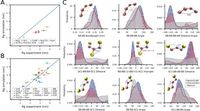In the complex world of molecular dynamics and biochemical simulations, intrinsically disordered proteins (IDPs) present unique challenges. These proteins, which lack a fixed or stable structure, account for a significant portion of the human proteome. However, they are notoriously difficult to model accurately, a task made even more challenging by existing computational limits on simulating such flexible molecules. Recent advancements in coarse-grained molecular dynamics modeling, particularly through the Martini force field, show promise in addressing these complexities.
A team of researchers recently unveiled an optimized version of the Martini model, called Martini3-IDP, specifically designed to enhance the representation of IDPs in simulations. Traditional Martini models have been noted for producing overly compact conformations, which restricted their ability to accurately reflect the physical behaviors of disordered proteins. By tuning bonded parameters in the Martini force field, the team created a model that not only better captures the expanded conformations of IDPs but also aligns more closely with experimentally derived measurements.
This innovative model marks a significant step forward in simulating IDPs by allowing for the accurate reproduction of their radii of gyration, a key metric for understanding the molecular structure and dynamics of these proteins. As the authors noted, "This model leads to expanded IDP conformations, greatly improving the reproduction of the experimentally measured radii of gyration." These adjustments improve the interaction balance with other molecular species, which is critical given that the function of IDPs often depends on their interactions with various partners in the cellular environment.
The potential applications of Martini3-IDP extend beyond merely improving the accuracy of IDP simulations. It also enhances the capacity to explore the interaction of IDPs with diverse biomolecular components, such as lipids and small molecules, while also examining the role of IDPs in phase separation processes that lead to the formation of biomolecular condensates. The optimized model successfully predicted the performance of IDPs in both homotypic and heterotypic systems, demonstrating its capability to capture the complexities of biomolecular interactions influenced by disordered proteins.
To validate Martini3-IDP, the researchers performed extensive testing, which included simulations of full-length multidomain proteins and the dynamics of IDP-lipid binding. The findings revealed that Martini3-IDP retains an accurate representation of IDP behavior across various environments—a critical factor for understanding cellular processes and functional interactions. As the team concluded, "We expand the ability to simulate processes involving IDPs in complex environments, at spatio-temporal scales inaccessible with all-atom models." This modeling advancement allows researchers to investigate the dynamics of IDPs in environments that standardized models could not accurately portray.
Furthermore, Martini3-IDP provides researchers with a powerful tool for studying disease mechanisms linked to dysregulation in IDP interactions, offering new pathways for therapeutic development. The intricate role that IDPs play in diseases such as cancer and neurodegenerative conditions highlights the importance of this modeling work in practical applications.
In conclusion, the development of the Martini3-IDP model exemplifies a significant leap towards capturing the dynamic nature of intrinsically disordered proteins. Addressing the shortcomings of previous models, it offers the scientific community new opportunities to advance molecular dynamics simulations by providing an accurate and reliable framework for studying IDPs. The capabilities of Martini3-IDP forge a path for future research into IDP function and interaction mechanisms, ultimately enhancing our understanding of fundamental biological processes.




